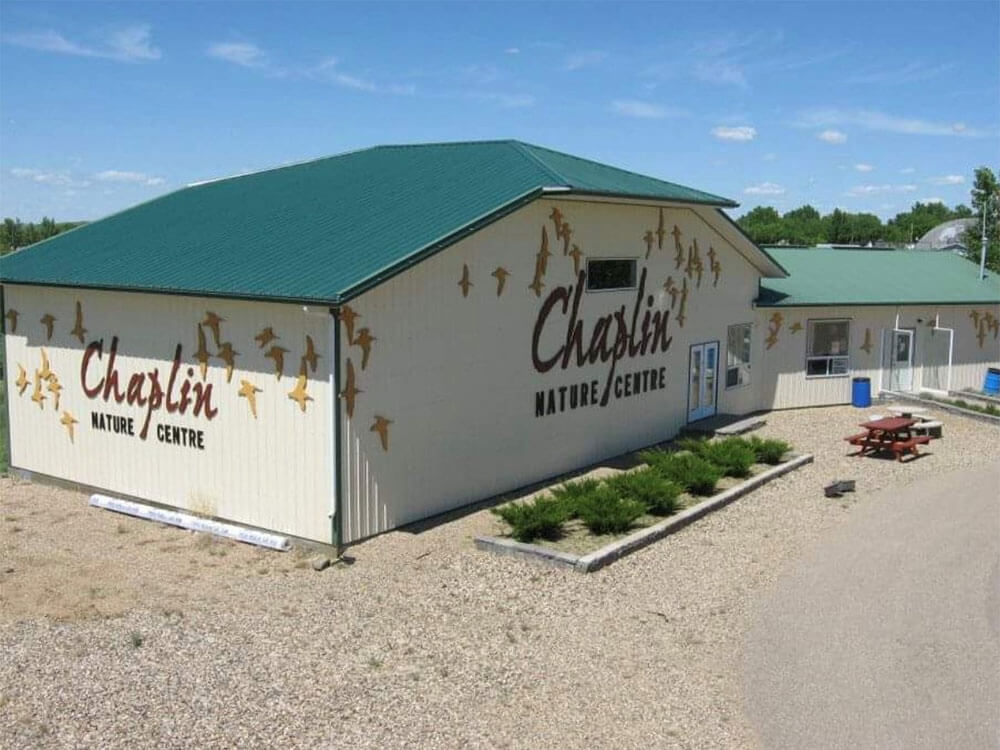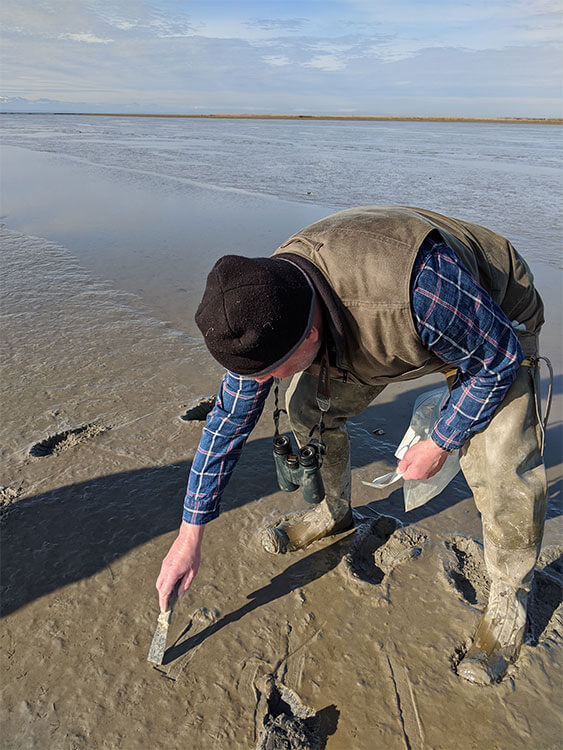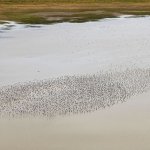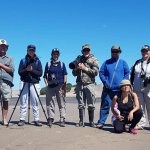Recently a small group of local residents gathered in the community center on Miscou Island, home to less than 600 people in New Brunswick, Canada to talk about the importance of their island for Whimbrels, Piping Plovers, and other shorebirds and the potential for a Western Hemisphere Shorebird Reserve Network (WHSRN) nomination. Stories of epic migrations of Whimbrel from a marsh on Miscou Island to northeastern Brazil enthralled guests and sparked questions about how a WHSRN nomination could support tourism and what impacts it would have on one of the island’s primary industries, blueberry farming; and what the commitment to conservation would entail.
The WHSRN Executive Office, Canadian Wildlife Service (CWS), and local partner Vert Rivages were able to draw on the experiences at other WHSRN sites to illustrate to community members how a WHSRN designation can be an opportunity for collaboration, capacity building, and international attention.
In 1987, WHSRN officially became a network when the Bay of Fundy joined as the second site. Since then six additional sites in Canada have been added to the Network. Effective place-based conservation action and collaboration across all sectors are needed to reverse shorebird population declines. WHSRN helps connect sites to each other, share the latest science and resources, highlight the importance of a site at an international level, motivate cooperation with natural resource users, and encourage decision-makers to consider shorebirds in planning.

Located on the Trans-Canada Highway, the Chaplin Nature Centre is in a prime location to teach travelers about shorebirds and the prairie ecosystem. Photo credit: Lori Wilson.
With a renewed focus on protected areas and shorebird conservation, CWS and the WHSRN Executive Office partnered during 2019-20 to support and enhance the capacity of WHSRN partners in Canada to engage with local governments, partners, stakeholders, and communities to build support for local action and strengthen international connections. Activities focused on the three designated sites Bay of Fundy, Chaplin Lakes – Old Wives – Reed Lakes, Fraser River Estuary, and two potential site Miscou Island and Mingan Archipelago.
In Quebec, Mingan Archipelago located on the north shore of the Gulf of St. Lawrence, is an important first stop for Red Knots on their southbound migration. Local NGO, Comité ZIP and CWS organized a meeting with Indigenous community of Ekuanitshit, Parks Canada, private landowners, municipalities, and stakeholders who use the area for recreation and ecotourism to discuss the importance of the site, a potential WHSRN nomination, and interests of the community. With a positive response, a nomination may move forward in 2020.
In contrast to the small communities of Miscou and Mingan, on Canada’s Pacific coast, WHSRN site Fraser River Estuary intersects with the over two million people living in the Fraser Delta.
Given the large human population, it may be challenging to reach every community member; site partners are working together to incorporate shorebird conservation into their programs. Birds Canada, one of the Fraser River Estuary’s lead site partners, facilitated a visit for me to visit the site. This visit provided an opportunity for shorebird conservation discussions with municipal, provincial, and federal government staff; nonprofit organizations, artists, and educators. The discussions reinforced and sparked new collaboration on restoration, research, education, and links to other sites.
James Casey, Fraser Estuary Specialist for Birds Canada, said, “The Network allows us to connect with other sites to learn from each other, sharing science, skills, and celebrations. These linkages blend the global and local conservation to not just build our capacity and move action forward, but remind us that we are not alone in this effort.”

One of the first to discuss the importance of biofilm for shorebirds, Dr. Bob Elner describes one of the conservation concerns at Roberts Bank, part of the Fraser River Estuary WHSRN site. Photo Credit: Laura Chamberlin.
In the prairies of Saskatchewan, the Chaplin-Old Wives-Reed Lake Complex has a strong history of community engagement and monitoring for migratory shorebirds. However, in recent years the Chaplin Lake Nature Centre and other community engagement activities have faced many challenges, including loss of leadership, degrading infrastructure, and lack of resources. Beyond these community engagement challenges there has been limited conservation action or planning at the site.
To address the long-term conservation needs at the site, the WHSRN Executive Office and Nature Conservancy of Canada initiated steps to build a coalition of stakeholders for collaboration on conservation, research, and education. This started with the completion of the WHSRN Site Assessment Tool to assess current management, threats, and actions needed. These results will then be used to develop an action plan, with a focus on reviving the Chaplin Lakes Nature Centre.
Back in the Atlantic Canada, at the site that made WHSRN a network, the Bay of Fundy expanded and changed its status to a Landscape of Hemispheric Importance in 2019. Establishing this landscape site involved working with The Confederacy of Mainland Mi’kmaq, Fort Folly First Nation, two provinces; many municipalities, landowners and other stakeholders. The designation of the expanded WHSRN Landscape represents the first step in a long-term effort to build collaborative shorebird conservation, education, and research across the Upper Bay of Fundy. With this project, five interpretative signs will be installed in the recently expanded parts of the WHSRN site, connecting residents and visitors from around the world to this important shorebird habitat and to the actions they can take to protect them.
WHSRN sites are more than just dots on a map. They are a constellation of willing partners who voluntarily commit to being good hosts to these avian travelers. In Canada, the recent engagement has expanded and strengthened site partners. Said Cynthia Pekarik, National Shorebird Conservation Coordinator, Canadian Wildlife Service, Environment and Climate Change Canada, “WHSRN sites in Canada are important stopovers for shorebirds – either as the last place before arriving on their nesting grounds or the first stop after the breeding season. It is essential for us to be connected to this network of partners, working together to continuously to ensure that these areas provide the resources required by shorebirds on their journeys.”
The Network and other site partners are strengthened by stronger partners in Canada, creating a Hemispheric force for shorebird conservation. Shorebirds need each stop on their migration. Without one, they are none.
Cover Photo: Whimbrels fly over the blueberry fields on Miscou Island which provide some of the habitat that supports over 1% of the biogeographic population of Whimbrels. Photo: Julie Paquet.






